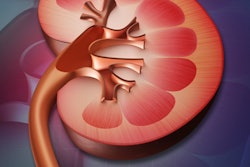
The higher the number of chest or abdominal CT exams in a hospital referral region, the greater the probability that patients will undergo a renal procedure, likely due to the incidental detection of renal masses, according to a study published online December 26 in JAMA Internal Medicine.
In a cross-sectional analysis, researchers led by Dr. H. Gilbert Welch from Dartmouth College examined data from more than 15 million fee-for-service Medicare beneficiaries at 306 hospital referral regions. They found that the likelihood of patients undergoing chest or abdominal CT exams positively correlated with full or partial surgical removal of their kidney.
"The narrow implication is simply that the more people receive abdominal and chest CTs, the more kidneys are removed," Welch told AuntMinnie.com. "But I believe there is a broader implication: More scanning leads to more incidental detection which, in turn, leads to more surgical intervention."
Questioning early detection
Welch has made a career of investigating the downstream effects of medical imaging for screening and early detection. He authored a 2012 paper in the New England Journal of Medicine that questioned whether mammography screening actually reduced the rate of advanced breast cancer, suggesting instead that it was leading to overdiagnosis -- the detection of lesions that would never pose a health risk to individuals.
 Dr. H. Gilbert Welch from Dartmouth College.
Dr. H. Gilbert Welch from Dartmouth College.He followed that up with a 2016 study that claimed better treatment -- not early detection -- was behind the documented reduction in breast cancer mortality over the past several decades. With the new study, Welch has turned his attention to other areas of radiology.
Radiologists have been reporting incidental tumors that are unrelated to initial clinical symptoms at an increasing pace since the early days of CT. These "incidentalomas" can be found in just about every organ, and each one can lead to unnecessary surgical procedures.
In one such case from the mid-1990s, Welch referred a patient with persistent hoarseness to an ear, nose, and throat specialist. During the diagnostic process, the patient underwent a chest x-ray as well as a chest CT, which revealed a small renal cell carcinoma, Welch said. This patient, who presented with hoarseness, ended up with a recommendation for a nephrectomy -- an invasive operation based on a coincidental finding that ultimately proved to be unnecessary.
The use of CT in medicine has led to a doubling in the observed incidence of kidney cancer in the U.S. since the early 1970s, as well as a 40% increase in the number of nephrectomies over the past 20 years, according to the authors. And yet the mortality rate of kidney cancer during the same period has remained stable, which suggests the overdiagnosis and overtreatment of renal tumors.
To confirm this notion, Welch and colleagues used Medicare claims from January 2010 to December 2014 at 306 hospital referral regions in the U.S. to determine the five-year risk of CT exams and nephrectomy for patients 65 to 85 years old. Among the more than 15.5 million fee-for-service Medicare beneficiaries, 43% underwent a chest or abdominal CT (JAMA Intern Med, December 26, 2017).
An analysis of the data revealed that the likelihood of having a CT exam and undergoing either total or partial nephrectomy had a statistically significant Pearson correlation coefficient (r) of 0.28 (p < 0.001). A value of "0" indicates no association between the variables, a "1" indicates a perfect positive correlation, and a "-1" indicates a perfect negative correlation. The farther the value of r is from "0," the greater the correlation.
The correlation between CT scanning and renal procedures grew slightly stronger when combining the two types of nephrectomy (from 0.28 to 0.38), and stronger still when restricted to hospital regions with increasingly more beneficiaries.
| Correlation between CT and renal procedures | |||
| All hospital regions | Hospital regions with over 20,000 Medicare beneficiaries | Hospital regions with over 50,000 Medicare beneficiaries | |
| CT exam and nephrectomy | r = 0.38 | r = 0.41 | r = 0.47 |
| CT exam and any renal procedure | r = 0.46 | r = 0.49 | r = 0.56 |
This trend continued for the association between CT exams and all renal procedures including renal ablation. After controlling for smoking, the researchers further discovered that there were an additional 5.5 renal procedures performed (four of which were nephrectomies) for every 1,000 more beneficiaries who underwent CT in a hospital region.
Wild goose chase
The observational nature of this study limited the researchers from determining a causal relationship between CT scanning and kidney surgery, or making judgments about the appropriateness of CT beyond established national guidelines, according to the authors. Still, these findings question the value of pursuing incidental findings on CT exams, as this can incur additional healthcare costs, cause patient anxiety, and result in health consequences from surgical intervention.
In response, Welch recommended three measures to help fine-tune the management of incidentalomas detected on CT:
Wait and watch. "Unless there are clear data to the contrary, our default action for an incidentally detected tumor should be watchful waiting, perhaps with a repeat scan three to six months later," he said. "It should not be surgical intervention."
Reconsider abnormal findings. There is a natural variation in what findings radiologists consider abnormal, and they should continue striving to improve the accuracy and consistency of diagnosis, according to Welch.
"We should not get into the trap of believing that the best radiologist is the one who finds the most abnormalities," he said. "The best radiologists are, instead, the ones who find the abnormalities that matter -- while not distracting clinicians by encouraging them to go on wild goose chases."
Adjust imaging threshold. "Clinicians should have a higher threshold to order [CT] scans in the first place," he said. "Scanning offers a great deal when there is a clear question to be answered, or in a patient who is acutely sick and injured, but many scans are ordered for much less clear reasons."
This is not to suggest that radiologists are purposefully overdiagnosing or that surgeons are intentionally performing unnecessary surgeries, the authors noted. Nevertheless, various forces such as financial interests, concern about litigation, and the push toward early diagnosis and treatment help propel these actions. Medical practitioners need to address said forces in the pursuit of more balanced medical care.
"I hope that other researchers will judge this line of inquiry as worthy of their time," Welch said. "There is a lot of fertile ground in incidental detection."



















